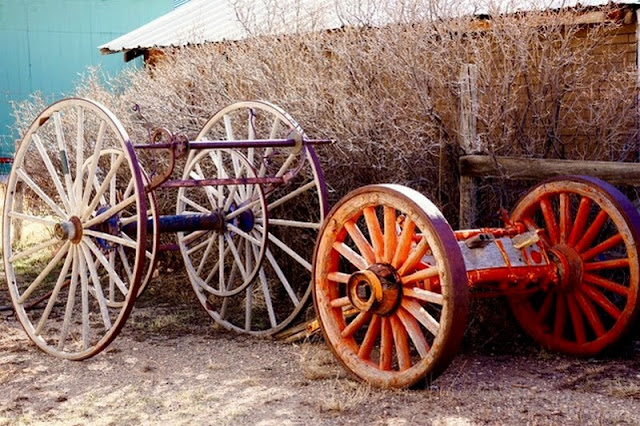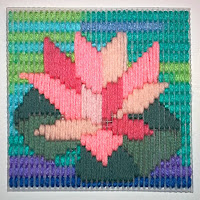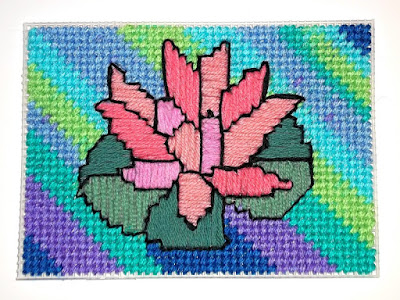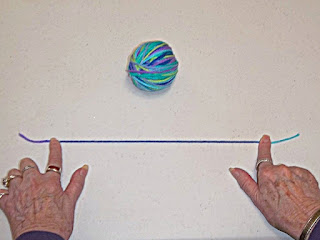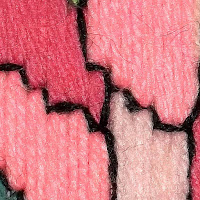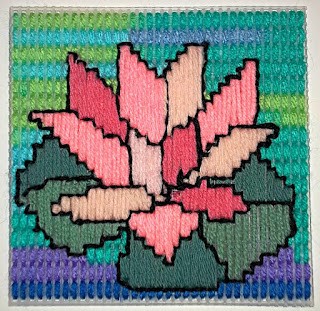| Two photos by J.J. |
You have now had enough experience with still life compositions to know whether you want to continue translating them into needlework. Now it is time to broaden your horizons a bit. Beside these first paragraphs, you will see a couple of photographs that you might not have considered as still lifes... but they are. I want you to extend your thinking about what constitutes a still life and where to find them. Still lifes do not have to be table-top compositions or pictures of items confined to the interior of a room. Any collection of items that are not going to get up and move away while you are sketching them (or photographing them for later sketching) will qualify. My grandfather, whose sketchbook I inherited, made some charming compositions of simple items like garden tools leaning against a fence. A collection of modern tools, including motorized ones, would make an even more intricate composition. (And, of course, you can always make a sketch of your drawing or needlework tools.)
| Amaryllis, in the style of a 19th century lithograph |
And then Louis Daguerre, through an unlikely — but happy — accident, discovered a whole new way to produce images, and what was to become a whole new art form, photography, was born. Some of the art world felt panic. People, they said, would no longer sit long hours to have their portraits painted; they would readily sit for long, uncomfortable minutes for the much cheaper photographs. Portrait painters did, in some cases, suffer from the new trend, but only temporarily. People did sit for those photographs, but people also began to buy more paintings of all kinds. And, as for Daguerre, the first daguerreotype he made to show the world was... a still life. (J.D., of course, considers this only right and proper!)
| Still life in the style of a daguerreotype - an homage to Louis Daguerre |
The Impressionists made significant discoveries about color. Remember when I advised you to put complementary colors into your shadows? That was one of many examples of their discoveries. By revisiting sites and painting them in all seasons, all weather, at different times of day, etc., they learned a great deal about how changing conditions altered colors. The pointillists discovered that putting tiny dots of mixed colors into an area of a painting gave it a more realistic aspect. Those dots are the “ancestors” of the pixels on your screen. (Latch-hook work is pointillism in action!) Although few of these painters concentrated on still lifes, their contributions improved overall understanding of the effects of light and color. In return, these also led to great improvements in the reproduction of both paintings and photographs.
We need to honor one more individual painter for his contribution to still lifes, the Post-Impressionist painter Paul Cezanne. He freed artists from the last restrictions on traditional still life compositions. In effect, he “tilted the table” so that everything on it was visible… and nothing fell off! J.D. is going to show you how he does some of this by changing perspectives with his camera.
| Different views of the same subject; only camera position and lighting was changed |
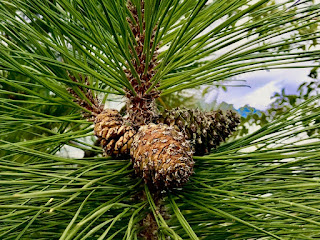 |
| Pine cones by J.J. |
Sometimes simply changing the scale of what you are observing brings up subjects you might not have thought about otherwise. Try “thinking small”. Look at individual plants, seashells, pine cones, mushrooms, etc., and their immediate surroundings. Often this will give you a new perspective on what constitutes a still life.
Now you have seen examples of 'translations' from observations, sketches, photographs and prints into samples of embroidery, needlepoint, latch-hook and other forms of stitchery. It is time for you to put what you have learned into serious practice. Use what you have learned to make an outline for a simple still life on cloth or canvas (even plastic canvas). Then fill in those outlines with your choice of yarns, flosses, or other materials, in your choice of colors, using your choice of stitches. When it is completed, you will have made something that would not exist in this world if you hadn’t created it. If that doesn’t make you feel good, I don’t know what will!
For more tutorials and suggestions, look for our next series of 'translations', Part I of LANDSCAPES, beginning later this spring.
 This post by Annake's Garden is licensed under a Creative Commons Attribution-NonCommercial-ShareAlike 3.0 Unported License.
This post by Annake's Garden is licensed under a Creative Commons Attribution-NonCommercial-ShareAlike 3.0 Unported License.